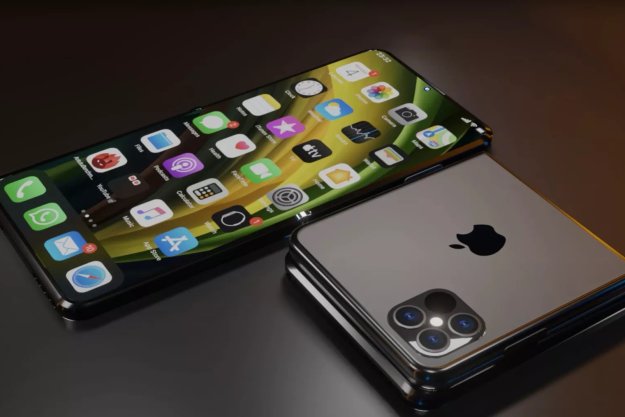Why does it always seem like every time there’s some kind of new innovation in mobile, everyone grabs onto it as fast as they can — everyone except Apple, that is. From multitasking to basic functions like copy and paste, Apple is usually the last one out of the gate. Often, that’s because Apple is waiting until it can make the feature awesome. Rather than adopting some kind of cobbled-together workaround, Apple will bide its time and work on a feature until it’s just as good as everything else on the phone.
So I started to wonder what it would be like for Apple to enter the foldable market. There are a lot of opportunities to be had, so let’s run some of them down.
An artist’s dream

Apple’s first foray into foldables may not come in the mobile space at all. Recent rumors point to Apple working on a foldable screen with a 20-inch display that would have a virtual keyboard in “laptop mode” or could be paired with an external keyboard and mouse to use when unfolded completely. This is not dissimilar to the ASUS Zenbook 17 we saw at CES this year. That laptop borrowed heavily from the ThinkPad X1 Fold from a few years ago.
The advantages here are obvious. A large screen that folds down into a smaller laptop-sized box is great. This kind of laptop would be an artist’s dream, and Apple has always appealed to the creator crowd. Obviously, a laptop that’s sold as a screen that could be used with an external mouse and keyboard lends itself to Apple-made accessories that it can sell. If there’s anything Apple has proven it loves to do, it’s selling accessories. If I had to come up with a random example totally off the top of my head, I might point to the $19 polishing cloth.
iPad on the go

If Apple wanted to scale things down a bit, there is something to be said for a tablet that folds up smaller to fit in your (hopefully not back) pocket. When you consider that the unfolded size of the Galaxy Z Fold 3 is almost the same size as the iPad Mini, the fruit seems to be hanging even lower. This would be an easy choice for Apple to make, and I have to say I’d be tempted by it since the iPad Mini is my current favorite iPad.
Folding tablets make a lot of sense for Apple since the company is dominating the tablet market. Apple has invested a lot of time, money, and effort into making tablets something that people actually want. One common criticism of Android foldables is that the
Personally, I’d love to see what Apple could do since it has both iOS and iPadOS so firmly under its belt. The software between the two is just different enough to make the two experiences distinct. That said, Apple doesn’t have a lot of experience with devices that change form factors like foldables. First-generation foldables all suffered from quirks and foibles when changing from a large screen to a smaller one. I’m not sure Apple is ready for those compromises.
Flipping out

If Apple was going to enter the foldable market in a way that already exists, my money would be on a folding iPhone in the vein of the Galaxy Z Flip 3. Of all the folding concepts that have come out, from phones to
The main reason for my love is because larger devices that fold have largely failed to live up to what they promise to be — multitasking machines. The Z Fold 3’s inner screen is too small to be a good productivity tablet. Larger devices like the ThinkPad X1 Fold are large enough when completely unfolded, but too small to work in laptop mode. There are compromises.
A folding iPhone would not only cater to Apple’s core “it just works” audience, but it would be great for everyday people who just want something smaller. Samsung has already shown that a folding phone can be had for under $1,000. It makes sense that Apple might pursue the same goal.
Slide into your pocket

So far, we’ve only examined Apple copying devices that you can already buy, but what about something different? To me, the most Apple-like way for Apple to enter the folding space would be to take a page from TCL’s book and develop a rolling concept. Perhaps we could have an iPhone that transforms into a more tablet-like experience. Having an iPhone that expands to the side with a rolling screen is something that just oozes Apple. It’s an elegant solution that eliminates gaps and allows Apple to stay in a relatively safe space in terms of design.
The key limitation here is that a phone can only stretch so far due to physical limitations. Would an iPhone that’s half as wide be truly useful? I’m not so sure, but if I had to put money on it, this would be my bet. It’s the one that just feels the most Apple to me.
Compromises to be overcome

If there’s anything that Apple seems to hate, it’s compromise. Apple prefers to deliver a product that is 100% ready in the fit and finish category. A folding device would not be allowed to have a gap at the fold because it’s ugly and lacks polish. A solution folding-screen
Apple also needs to back further away from the thin-and-light focus that got it into so much trouble in the “butterfly keyboard” days. Apple eventually did back off that stance, but it’s one thing to offer a laptop that’s a few millimeters thicker than its predecessor. It’s another thing to offer folding
Finally, there’s the one area that no one has really solved yet — the software experience. Software generally does not like it when the screen it’s running on changes shape. Apple will have to think long and hard about how that’s going to work. Being in total control of the operating systems involved should be helpful in crossing that final finish line.
Getting it right
There’s no reason to think Apple couldn’t pull it off, though. In fact, it’s a sure bet that Apple will not enter the foldable market until it has addressed each and every one of those compromises. It’s possible that another manufacturer will solve those problems first, and that’s OK. If there’s anything we’ve learned about Apple, it’s that it doesn’t mind being late for the party. For the rest of us, that’s fine. There are plenty of
Editors' Recommendations
- Here’s how Apple could change your iPhone forever
- The DOJ has sued Apple over the iPhone. Here’s what it means for you
- Apple just released iOS 17.4. Here’s how it’s going to change your iPhone
- Apple may announce new iPads next month. Here’s everything we expect
- Apple Sports app looks to rule live scores and stats on iOS




